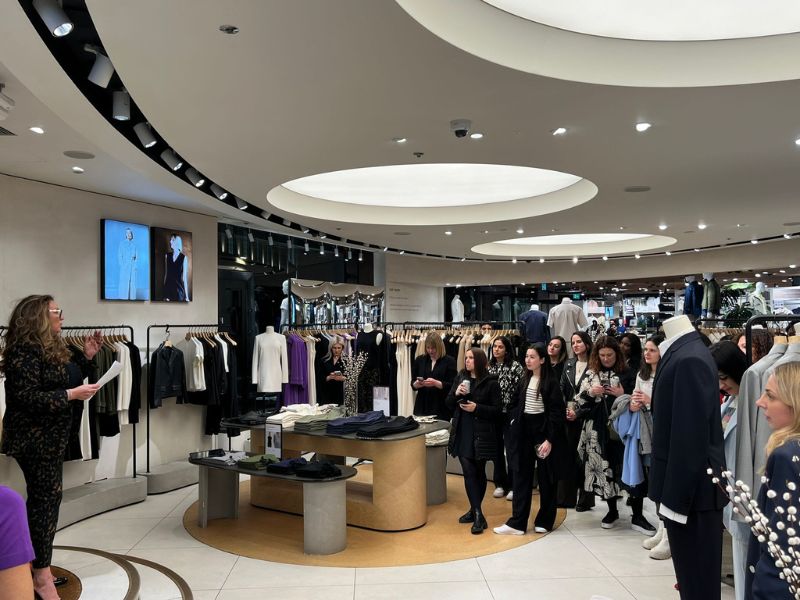From that moment on, I devoted all my waking hours to lovingly documenting his every move in scrapbook after scrapbook (a dozen in all) and spent art class at school painting his portrait, mostly wearing outlandish new outfits designed by yours truly. I even fashioned a clay bust of him in pottery class. Bowie’s influence on my life has been major, from the fundamental desire to never be labelled or pigeonholed to my profound love of glitter and penchant for a spikey haircut. And I am not alone.
One of the few rock stars that has truly traversed music, film, art and fashion, over his career Bowie stitched them together to create indefinable hybrids (only to then merrily ditch his latest fascination whenever the whim took him). As a forthcoming VA exhibition shows, remarkably his visionary perspective has proved a constant source of inspiration down the generations for music makers, artists and fashion designers.
You certainly couldn’t miss Bowie’s presence in the spring/summer 2013 collection of Jean Paul Gaultier, as model Franzi Mueller walked the runway dressed as Bowie’s alter-ego Ziggy Stardust. Mueller modelled a one-shouldered, one-legged knitted catsuit just like the one sported by Bowie on stage in 1973. With her bright-orange, toilet-brush hairdo she looked every bit as startling as the original.
Bowie’s influence was also in evidence at the latest round of menswear shows. Walter Van Beirendonck channelled the rock star with jackets slashed with the same Aladdin Sane lightening flash painted on Bowie’s face for the iconic album cover. This time around, the flash was in Lurex, a favourite glam rock fabric.
There have been many sightings of Bowie on the catwalks down the years, some oblique and some more obvious. In 2011, there was no mistaking the inspiration for designer Dries Van Noten, who sent out male models rocking Bowie’s red/blond, slicked-back hairdo dressed in slouchy monochromatic tailoring straight from the stage of the singer’s 1976 ‘Station To Station’ tour.
Bowie himself has long been aware of the power of fashion, often making reference in his songs – a swish of “satin and tat” here, a “slashed back blazer” there. In the lyrics of his first hit, “Space Oddity”, the abandoned astronautf Major Tom is contacted by Ground Control only to be told, “…the papers want to know whose shirts you wear?”. One of his most enduring hits, “Fashion”, has become the soundtrack for many a catwalk show and daytime TV fashion item.
Throughout his career, Bowie has been keen to work with designers at the cutting edge of the industry in an effort to push the boundaries and challenge the status quo. At the dawn of the 1970s, he did just that when, looking like the bastard son of Lauren Bacall and Rudolf Valentino, he donned what he described as “a man’s dress” by Mayfair boutique owner Michael Fish for the cover of his The Man Who Sold the World album. His androgynous image proved too much for the record company and this photograph was replaced on US and later UK pressings.
A year or so later, when Bowie began shaping his Ziggy Stardust image, he enlisted Freddie Burretti and Natasha Korniloff to stitch up futuristic quilted jumpsuits and bomber jackets from quaint Liberty prints and sparkly brocades. It was a look Bowie described as “a cross between Nijinsky and Woolworths”. With the addition of boxing boots, there was a nod to the Droogs, the nihilistic hoodlums that featured in Stanley Kubrick’s provocative Clockwork Orange film, the soundtrack of which Bowie would use for his entrance on stage.
While flicking through glossy fashion magazines, Bowie discovered Japanese designer Kansai Yamamoto, who unveiled his designs in London in 1971 in a show that featured several of the outfits later worn by the singer. It also included some influential theatrics, such as the use of kuroko, traditional kabuki stagehands, for a series of quick-change outfits.
Not only did Bowie commission Yamamoto to design the costumes for his ‘Aladdin Sane’ tour (these included the aforementioned unitard, a satin cape printed with Japanese script and a skimpy all-in-one decorated with frolicking woodland creatures), he also lifted the spiky hairdo that the models sported, along with their red-and-black wedge boots. Apparently, Bowie baulked at shelling out the equally high-rise designer price tag and had PVC copies made. Yamamoto also fashioned glittering ensembles for the singer that were part-Samurai, part-sci-fi hero.
More than two decades later, Bowie collaborated with designer Alexander McQueen, the poster-boy of fashion’s avant-garde, to design a frock coat tailored from a tattered Union Jack flag. The admiration between the artists was mutual; McQueen dressed model Kirsten Owen as Ziggy for one of his more colourful couture shows at Givenchy.
Owen is not the only supermodel who has dragged up as Bowie. Kate Moss has done so twice on the covers of British and Paris Vogue. The image that featured on his 1973 Pin Ups album was originally shot as a proposed cover for British Vogue. Posing with model Twiggy, who Bowie had name-checked on a previous album, the pair wore masks of make-up.
The mask has become a constant metaphor for Bowie who delights in trying on a new identity with the release of each album. Another reason why fashion fans, who share his love of creating characters with clothes, have anointed him their patron saint.
Yet the popular myth that David Bowie invented reinvention is patently not true. Part of Marie Antoinette’s downfall was due to her fondness for playing dress-up as an unworldly shepherdess, while in pop it was the clever marketing strategy of managers such as Larry Parnes who, in the 1950s and 1960s, made-over pretty-boy singers into idols worthy of star billing: Billy Fury, Vince Eager and Marty Wilde.
Bowie is, however, a clever curator with an antenna attuned to the Next Big Thing. Throughout his career he has been a sponge for cultural nuance. Whether a prophet, a messiah or just easily bored, Bowie made it his thing to always be one stylish step ahead of his audience. In a review of the opening night of the ‘Diamonds Dogs’ tour in 1974, a rock critic noted how Bowie stepped out on stage in a pair of flat ballet pumps, much to the chagrin of his ‘platformed-to-death’ fans. Such about-turns went beyond his wardrobe, as equally quickly he stripped back the Broadway-style backdrops and theatrical staging of this show and replaced it with a bare-bones, raw musical experience.
Bowie’s music, and look, was never intended to be easy on the ear or eye, so, even as a die-hard fan, just when you thought you’d got the hang of it or had braved it out to parade his latest hairdo down your local high street, off he would go in a totally different direction, taking you with him on another exotic adventure. Through Bowie you got to discover the wonders of Egon Schiele (cover of Heroes), Lindsay Kemp (stage show), Jean Genet (sexual ambivalence) or William Burroughs (cut-up lyrics). Bowie was unashamed to make explicit reference to art, be it Dali, Duchamp or Warhol. I learnt about Jean Cocteau and Jacques Brel alongside Iggy Pop and Lou Reed.
Bowie has oft been described as a style magpie (his doubters are less charitable) but, whatever your viewpoint, it cannot be deniedf that he has been a crucial influence in helping to create a tradition handed down to artists from Madonna to Marc Jacobs, Galliano to Gavin Turk. Referencing has now become common currency in music, fashion and art. What made Bowie stand out from the crowd was how he combined all three mediums into a new art form that often defied categorisation.
Bowie’s obsession with style obviously has its roots during his early Mod beginnings in the 1960s when, along with a teenage Mark Feld (soon to be Marc Bolan), he embraced the fastidious focus of the tiniest sartorial details – the importance of the placement of a covered- button or the length of a turn-up. Mod was a breeding ground for experimentation with image and sexuality. Androgyny flourished among the male faces of Mod, who were not adverse to a smidge of make-up. These became key factors in Bowie’s presentation of himself as a rock star.
Yet what marks Bowie a true style icon, in a league with Katharine Hepburn, Marlene Dietrich or James Dean, is that his off-duty wardrobe has been equally inspirational. Whether the ensembles donned by Bowie to pop out for a pint of milk were as carefully considered and constructed as his stage gear is up for debate, certainly his self-image was so entangled with his stage personas that the two often overlapped.
Offstage, his arresting jackets and suits, exquisitely tailored by Burretti, exuded pure unadulterated glamour, but often Bowie made the ordinary appear alluring. During his sojourn in Berlin, he sported flat caps and flip-flops while on the set of The Man Who Fell To Earth, he even looked cool in a duffel coat. And sometimes the combinations were just out-and-out odd. In a family portrait with Rapunzel-haired son Zowie, mum Angie models a leather halterneck jumpsuit, while Bowie is dressed up as a kind of Spanish pirate – pedal-pushers, platform boots, velveteen zip jacket and, the ultimate accessory, an eye-patch.
After that first sighting of Bowie singing on Top of the Pops, a pair of girl’s lace-up platform shoes were duly purchased from the small ads at the back of the NME, while the Ziggy Stardust cropped pedal-pusher trousers were copied in part from the fashion favoured by Smoothies (teens that were followers of the TV show Budgie, featuring a cheeky chancer portrayed by actor Adam Faith). I cut my hair at the kitchen sink into a very bad approximation of his spikey hairdo and wore ‘Antique Green’ nail polish.
One Saturday, my mum returned from her regular shopping trip to the nearby town carrying a brown paper bag. It contained a second-hand fox fur, which I draped over my shoulder when watching Match of the Day with my dad. As Bowie went from snug, bum-freezer jackets to swimming in roomy demob suits, my own version came from the back of my dad’s wardrobe. I wore this with a trilby and a pair of Mary Jane shoes. Poor dad.
I cajoled my mum to knit the spotty blue-and-white jumper on the cover of David Live. She even had to knit a second one for my best friend Alison Scriven. Another favourite sweater was the slash-neck, black skinny rib that she cleverly copied from the photographs I had cut from the Melody Maker of Bowie in Sigma Studios recording sessions for Young Americans. During my teenage years I spent most of my waking hours pasting pictures of Bowie in scrapbooks alongside any mention of him in the press. I am now thrilled to have one of these scrapbooks displayed along with one of my teenage paintings of Bowie and a letter from his mum in the VA show, “representing the thousands of fans sitting in bedrooms across the UK whose lives were similarly affected,” says curator Victoria Broackes.
The timing of the Bowie exhibition is apposite, coming as it does just before the museum’s other promised blockbuster, From Club to Catwalk (an exploration of 1980s fashion and club culture), given the former’s influence on the latter.
In 1980, when Bowie planned to make a video to accompany “Ashes to Ashes”, he visited the Blitz nightclub to handpick his co-stars, among them Steve Strange wearing designer Judith Frankland’s black wedding dress. Frankland walked alongside Strange, behind Bowie who was now dressed as a clown by long-time collaborator Korniloff. The Blitz’s New Romantic crowd had started life at a Bowie night at Billy’s nightclub in Soho. It was Bowie’s original flamboyance that caught the imagination of the hardcore style snobs that formed the New Romantic scene and indeed what secures Bowie’s credentials as a style icon is his elitist standpoint. Over the years he has constantly defied convention and continued to present himself as the exquisite outsider.
And Bowie keeps swinging. In this day and age of surgically airbrushed style-icons, it is inspiring that in the video for “Where Are We Now?” Bowie actually looks like a man of 66, albeit a very elegant, stylish man who has been there and back. No fillers, no Botox. Ever the rebel (rebel).
David Bowie Is opens at the VA, London SW7 on 23 March








